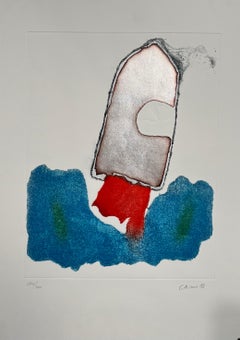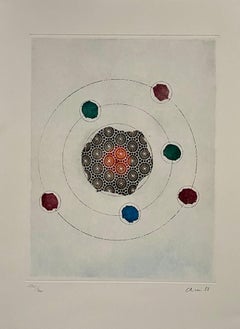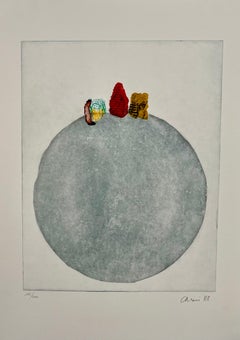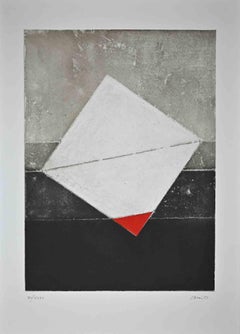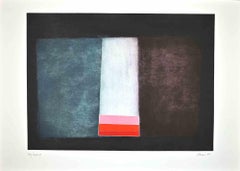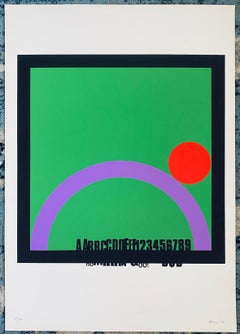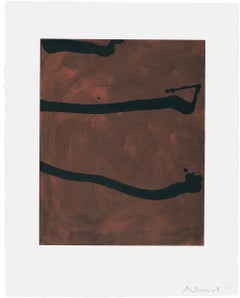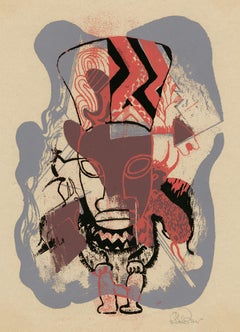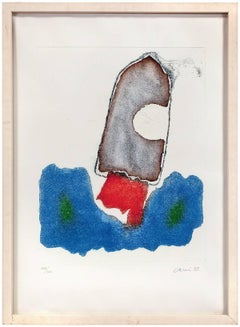Eugenio Carmi Art
to
11
Overall Width
to
Overall Height
to
11
11
3
1
1
9
2
10
6
1
13
7,820
5,167
2,504
1,501
7
4
Artist: Eugenio Carmi
Italian Abstract Aquatint Collage Lithograph Print Eugenio Carmi 80s Memphis Era
By Eugenio Carmi
Located in Surfside, FL
Genre: Modern, Modernist
Subject: Abstract
Medium: Print, Aquatint with metal foil
Hand signed dated 1988, limited edition
Surface: Paper
Country: Italy
Dimensions: 26" x 20" approxi...
Category
1980s Post-Modern Eugenio Carmi Art
Materials
Aquatint
Italian Abstract Aquatint Collage Lithograph Print Eugenio Carmi 80s Memphis Era
By Eugenio Carmi
Located in Surfside, FL
Genre: Modern, Modernist
Subject: Abstract
Medium: Print, Aquatint with metal foil
Hand signed dated 1988, limited edition
Surface: Paper
Country: Italy
Dimensions: 26" x 20" approxi...
Category
1980s Post-Modern Eugenio Carmi Art
Materials
Aquatint
Italian Abstract Aquatint Collage Lithograph Print Eugenio Carmi 80s Memphis Era
By Eugenio Carmi
Located in Surfside, FL
Genre: Modern, Modernist
Subject: Abstract
Medium: Print, Aquatint
Hand signed dated 1988, limited edition
Surface: Paper
Country: Italy
Dimensions: 26" x 20" approximately
Eugenio ...
Category
1980s Post-Modern Eugenio Carmi Art
Materials
Aquatint
Abstract Composition - Etching by Eugenio Carmi - 1983
By Eugenio Carmi
Located in Roma, IT
Abstract Composition is an original etching realized in the 1960s by Eugenio Carmi (Genoa, February 17, 1920 - Lugano, February 16, 2016).
Hand-signed and dated in pencil on the lo...
Category
1980s Surrealist Eugenio Carmi Art
Materials
Etching
Abstract Composition - Etching by Eugenio Carmi - 1987
By Eugenio Carmi
Located in Roma, IT
Abstract Compositionis an original etching made by Eugenio Carmi (Genoa, 1920 - Lugano, 2016) in 1987.
Good conditions.
Hand signed and numbered. Edition, VIII/XXXV.
Eugenio Carmi...
Category
1980s Abstract Eugenio Carmi Art
Materials
Etching
Italian Artist Modern Silkscreen Eugenio Carmi
By Eugenio Carmi
Located in Surfside, FL
Eugenio Carmi is an Italian painter born in 1920 in Genoa. He studied in Turin in Felice Casorati’s studio. His experience as a graphic designer in the ‘50s, is decisive for his pict...
Category
1980s Modern Eugenio Carmi Art
Materials
Screen
Abstract Composition - Etching by Eugenio Carmi - 1987
By Eugenio Carmi
Located in Roma, IT
Abstract Composition is an original etching made by Eugenio Carmi (Genoa, 1920 - Lugano, 2016) in 1987.
Good conditions.
Hand signed and numbered. Edition, VIII/XXXV.
Eugenio Carm...
Category
1980s Abstract Eugenio Carmi Art
Materials
Etching
Abstract Composition - Etching by Eugenio Carmi - 1987
By Eugenio Carmi
Located in Roma, IT
Abstract Composition is an original etching realized by Eugenio Carmi in 1987.
Good conditions
Numbered. Edition, VIII/XXXV.
The artwork is depicted in a well-balanced composition.
Category
1980s Abstract Eugenio Carmi Art
Materials
Etching
Italian Abstract Aquatint Collage Lithograph Print Eugenio Carmi 80s Memphis Era
By Eugenio Carmi
Located in Surfside, FL
Genre: Modern, Modernist
Subject: Abstract
Medium: Print, Aquatint
Hand signed dated 1988, limited edition
Surface: Paper
Country: Italy
Dimensions: 26" x 20" approximately
Eugenio ...
Category
1980s Post-Modern Eugenio Carmi Art
Materials
Aquatint
Italian Abstract Aquatint Collage Lithograph Print Eugenio Carmi 80s Memphis Era
By Eugenio Carmi
Located in Surfside, FL
Genre: Modern, Modernist
Subject: Abstract
Medium: Print, Aquatint
Hand signed dated 1988, limited edition
Surface: Paper
Country: Italy
Dimensions: 26" x 20" approximately
Eugenio ...
Category
1980s Post-Modern Eugenio Carmi Art
Materials
Aquatint
Italian Abstract Aquatint Collage Lithograph Print Eugenio Carmi 80s Memphis Era
By Eugenio Carmi
Located in Surfside, FL
Genre: Modern, Modernist
Subject: Abstract
Medium: Print, Aquatint
Hand signed dated 1988, limited edition
Surface: Paper
Country: Italy
Dimensions: 26" x 20" approximately
Eugenio ...
Category
1980s Post-Modern Eugenio Carmi Art
Materials
Aquatint
Related Items
Untitled
By Robert Motherwell
Located in London, GB
Brushed aquatint, lift-ground etching and aquatint on German Etching paper
71.8 x 56.5 cms (28 1/4 x 22 1/4 ins)
Edition of 32
Category
1970s Abstract Eugenio Carmi Art
Materials
Etching, Aquatint
'African Idol' — American Modernism
By Robert Vale Faro
Located in Myrtle Beach, SC
Robert Vale Faro, untitled (African Idol), serigraph, c. 1940, edition 6. Signed in pencil. A fine impression, with fresh colors, on buff wove paper; the full sheet with margins(5/8 to 1 3/8 inches), in excellent condition. Very rare. Matted to museum standards, unframed.
Image size 8 3/4 x 6 inches (222 x 152 mm); sheet size 11 x 7 1/2 inches (279 x 192 mm).
ABOUT THE ARTIST
Robert Vale Faro (1902-1988) was a well-known modernist architect and artist associated with the Chicago Bauhaus. He received his degree in architecture and design from the Armour Institute in Chicago and worked at L'Ecole des Beaux-Arts, Paris, from 1924-27, where he was influenced by Harry Kurt Bieg and Le Corbusier. Upon his return to Chicago, Faro worked with the important modernist Chicago architects George and William Keck under Louis Sullivan.
Faro founded the avant-garde printmaking group Vanguard in 1945. The group counted Atelier 17 artists Stanley William Hayter, Sue Fuller, and Anne Ryan as New York members and Francine...
Category
1940s American Modern Eugenio Carmi Art
Materials
Screen
The sun, from The Hippies
By Salvador Dalí
Located in Washington, DC
Artist: Salvador Dali
Title: The sun
Portfolio: The Hippies
Medium: Color etching on Arches
Date: 1969
Edition: 102/145
Frame Size: 31" x 26 1/2"
Sheet Size: 26" x 20"
Image Size: 15...
Category
1960s Surrealist Eugenio Carmi Art
Materials
Etching
The corridor of Katmandu, from The Hippies
By Salvador Dalí
Located in Washington, DC
Artist: Salvador Dali
Title: The corridor of Katmandu
Portfolio: The Hippies
Medium: Etching on Arches wove paper
Date: 1969
Edition: Unnumbered proof
Frame Size: 34 1/4" x 27 1/2"
S...
Category
1960s Surrealist Eugenio Carmi Art
Materials
Etching
Berkeley:Suite
By McArthur Binion
Located in New York, NY
Edition of 35, sold unframed.
This print is part of the ‘Berkeley:Suite’ series, which includes various layered combinations of McArthur Binion’s 1970s self-portrait, a snapshot of...
Category
2010s Contemporary Eugenio Carmi Art
Materials
Aquatint
"Omniverso" Omniverse - contemporary, surrealist, graphic, geometric sun print
By Pedro Friedeberg
Located in Ciudad de México, MX
The repetition of patterns and rhythm is present in almost every piece of Pedro´s work.
The hybrid topographies that Pedro Friedeberg´s unclassifiable practice recreates we must rec...
Category
21st Century and Contemporary Surrealist Eugenio Carmi Art
Materials
Digital
Untitled #2 Color etching, aquatint on Hahnemühle paper Signed/N ex-Deutsch Bank
By Thomas Nozkowski
Located in New York, NY
Thomas Nozkowski
Untitled #2, 2008
Color etching with aquatint on Hahnemühle paper
Signed and numbered 5/35 in graphite on the back. Die cut window flap on the back of the frame reve...
Category
Early 2000s Abstract Expressionist Eugenio Carmi Art
Materials
Etching, Aquatint
Invitation au Musee, original museum poster
By Niki de Saint Phalle
Located in New York, NY
Niki de Saint Phalle
Invitation au Musee, original museum poster, 1993
Silkscreen on wove paper
16 × 24 inches
Unframed (not signed)
original p...
Category
1990s Modern Eugenio Carmi Art
Materials
Screen
Des Ongles et Du Bec (abstract female portrait)
By Georges Rouault
Located in Wilton Manors, FL
Artist Georges Rouault
(1871, France - 1958, France)
Main title
"Des ongles et du bec"
Etching and aquatint on wove paper.
Creation date
1926 / 1948
Publisher: Etoile Filante, P...
Category
Mid-20th Century Abstract Eugenio Carmi Art
Materials
Etching, Aquatint
Original AIRS DE CHANCE Loterie Nationale original French lottery poster
Located in Spokane, WA
Original AIRS DE CHANCE Loterie Nationale French vintage poster. Translated, it means, "In the moonlight, my friend Pierrot, lend me your money to win the jackpot." Linen-backed original French lottery...
Category
1960s Surrealist Eugenio Carmi Art
Materials
Lithograph
H 15 in W 11.5 in D 0.1 in
The Blue Rider
By Max Papart
Located in San Francisco, CA
Max Papart (1911-1994) "The Blue Rider" Original Etching with Aquatint, circa 1973
This is a rare artist proof. The artist proof is pencil signed and titled by the artist.
The regu...
Category
Mid-20th Century Abstract Eugenio Carmi Art
Materials
Etching, Aquatint
Untitled (A)
By Thomas Nozkowski
Located in New York, NY
Thomas Nozkowski (b. 1944, Teaneck, New Jersey; d. 2019, New York) was recognized for his richly colored and intimately scaled abstract paintings, drawings, and prints that push the...
Category
Early 2000s Abstract Eugenio Carmi Art
Materials
Color, Aquatint
Previously Available Items
Italian Artist Modern Silkscreen Eugenio Carmi
By Eugenio Carmi
Located in Surfside, FL
Eugenio Carmi is an Italian painter born in 1920 in Genoa. He studied in Turin in Felice Casorati’s studio. His experience as a graphic designer in the ‘50s, is decisive for his pictorial research, based on a rigorous geometrical structure and on a fine analysis of the perception of colors.
He participated in the Venice Biennale in 1966.
In 1967 he showed some electronic works in the Superlund exhibition organized by Pierre Restany in Lund, Sweden.
In 1968, he introduced the “Carm-o-matic”, during the Cybernetic Serendipity show at the Institute of Contemporary Art in London.
In 1973, he produced an entirely abstract 25-minute show for RAI’s Experimental Programs Service. The same year, he taught visual art seminars at the Rhode Island Institute of Design in the United States.
In the ‘70s, he gave courses at the Accademia of Macerata and at the Accademia of Ravenna (Italy).
He produced illustrations for three of Umberto Eco’s stories, published in Italy by Bompiani and in many other countries. The French Ministry of Education has selected them for libraries and schools in France.
The most important retrospective of his work was organized by the Milan town hall in 1990, followed by a prestigious exhibition in Budapest, in the halls of the Royal Palace, in 1992.
In 1991 he exhibited at the San Francisco Italian American Museum.
In 1996 the “Carmi” book is published by Umberto Eco and Duncan Macmillan and presented at the Milan Triennial: a synthesis of his life.
From 1957 to 1965 he will play the role of artistic director of Cornigliano's corporate magazine.
During this time iron and steel are materials that Carmi meets every day and become a strong creative stimulus for him. In his first solo exhibition - presented by Gillo Dorfles in 1958 at the Galleria Numero di Firenze - the protagonists are the enamels on steel and since 1960 he made various iron and steel works welded and lithographed milk.
Iron and steel is the work that in 1962 presented at Spoleto Sculpture exhibition in the city , organized by Giovanni Carandente under the V Festival of the Two Worlds .
In this period, he is involved not only in the cultural politics of the Istallier ( Victor Vasarely , Umberto Eco , Max Bill , Konrad Wachsmann , Furio Colombo , Ugo Mulas , Kurt Blum , Emanuele Luzzati , Flavio Costantini ) , But also in the cultural activity of the Warehouse Gallery , which Carmi founded in Boccadasse in 1963. The Warehouse Gallery with multiples intends to propose a serial art accessible to a wider audience and is placed in international discussions on 'Multiplied Art, representing one of the most important examples.
The friendship and mutual esteem that binds him to Umberto Eco has two very important fruits at this time: Children's Fables and Stripsody . In 1966 for the publishing house Bompiani came three Eco fables illustrated by Carmi and then re-introduced in 1988 with new Carmi illustrations and a fable more. Stripsody is a musical project on cartoon sound, designed and then interpreted by the genius singer Cathy Berberian, with Eco texts and illustrations by Carmi.
Eugenio Carmi, who is always fascinated by the new technological possibilities in the 1960s and 1970s, is the author of experimental cinematic and audiovisual artwork and also realizes those who will call electrical imagery signals that will also be at the center of a provocative installation on the streets of the city of Caorle .
It is at this stage that in 1966 he was at the XXXIII edition of the Venice Biennale with the electronic work SPCE (electronically controlled polycyclic structure), which is also the invitation of Pierre Restany to participate with electronic works at the SuperLund exhibition in Sweden.
In 1971, he moved to Milan with his family, where he established his study.
At this point, though with incursions in other parallel fields such as the realization of mirrors and stained glass, painting, and sporadically sculpture - which had approached the Istal period - is at the center of its activity. It is at the beginning of the seventies that it deepens the geometric language, already open with some previous experiences (accident prevention signs for the Italsider, some multiples for the Deposit and electrical imagery signals), replacing it with the informal one.
In 1979 he produced a magazine - which will remain the same number - by the name of Res Publica , for which he receives the contributions of intellectuals and artists, including Umberto Eco, Antonio Porta , Gillo Dorfles , Richard Paul Lohse...
Category
1980s Modern Eugenio Carmi Art
Materials
Screen
Abstract Composition Aquatint collage
By Eugenio Carmi
Located in Surfside, FL
Genre: Modern
Subject: Abstract
Medium: Print, Aquatint
Surface: Paper
Country: United States
Dimensions w/Frame: 26" x 19"
Eugenio Carmi is an Italian painter born in 1920 in Genoa. He studied in Turin in Felice Casorati’s studio. His experience as a graphic designer in the ‘50s, is decisive for his pictorial research, based on a rigorous geometrical structure and on a fine analysis of the perception of colors.
He participated in the Venice Biennale in 1966.
In 1967 he showed some electronic works in the Superlund exhibition organized by Pierre Restany in Lund, Sweden.
In 1968, he introduced the “Carm-o-matic”, during the Cybernetic Serendipity show at the Institute of Contemporary Art in London.
In 1973, he produced an entirely abstract 25-minute show for RAI’s Experimental Programs Service. The same year, he taught visual art seminars at the Rhode Island Institute of Design in the United States.
In the ‘70s, he gave courses at the Accademia of Macerata and at the Accademia of Ravenna (Italy).
He produced illustrations for three of Umberto Eco’s stories, published in Italy by Bompiani and in many other countries. The French Ministry of Education has selected them for libraries and schools in France.
The most important retrospective of his work was organized by the Milan town hall in 1990, followed by a prestigious exhibition in Budapest, in the halls of the Royal Palace, in 1992.
In 1991 he exhibited at the San Francisco Italian American Museum.
In 1996 the “Carmi” book is published by Umberto Eco and Duncan Macmillan and presented at the Milan Triennial: a synthesis of his life.
From 1957 to 1965 he will play the role of artistic director of Cornigliano's corporate magazine.
During this time iron and steel are materials that Carmi meets every day and become a strong creative stimulus for him. In his first solo exhibition - presented by Gillo Dorfles in 1958 at the Galleria Numero di Firenze - the protagonists are the enamels on steel and since 1960 he made various iron and steel works welded and lithographed milk.
Iron and steel is the work that in 1962 presented at Spoleto Sculpture exhibition in the city , organized by Giovanni Carandente under the V Festival of the Two Worlds .
In this period, he is involved not only in the cultural politics of the Istallier ( Victor Vasarely , Umberto Eco , Max Bill , Konrad Wachsmann , Furio Colombo , Ugo Mulas , Kurt Blum , Emanuele Luzzati , Flavio Costantini ) , But also in the cultural activity of the Warehouse Gallery , which Carmi founded in Boccadasse in 1963. The Warehouse Gallery with multiples intends to propose a serial art accessible to a wider audience and is placed in international discussions on 'Multiplied Art, representing one of the most important examples.
The friendship and mutual esteem that binds him to Umberto Eco has two very important fruits at this time: Children's Fables and Stripsody . In 1966 for the publishing house Bompiani came three Eco fables illustrated by Carmi and then re-introduced in 1988 with new Carmi illustrations and a fable more. Stripsody is a musical project on cartoon sound, designed and then interpreted by the genius singer Cathy Berberian, with Eco texts and illustrations by Carmi.
Eugenio Carmi, who is always fascinated by the new technological possibilities in the 1960s and 1970s, is the author of experimental cinematic and audiovisual artwork and also realizes those who will call electrical imagery signals that will also be at the center of a provocative installation on the streets of the city of Caorle .
It is at this stage that in 1966 he was at the XXXIII edition of the Venice Biennale with the electronic work SPCE (electronically controlled polycyclic structure), which is also the invitation of Pierre Restany to participate with electronic works at the SuperLund exhibition in Sweden.
In 1971, he moved to Milan with his family, where he established his study.
At this point, though with incursions in other parallel fields such as the realization of mirrors and stained glass, painting, and sporadically sculpture - which had approached the Istal period - is at the center of its activity. It is at the beginning of the seventies that it deepens the geometric language, already open with some previous experiences (accident prevention signs for the Italsider, some multiples for the Deposit and electrical imagery signals), replacing it with the informal one.
In 1979 he produced a magazine - which will remain the same number - by the name of Res Publica , for which he receives the contributions of intellectuals and artists, including Umberto Eco, Antonio Porta , Gillo Dorfles , Richard Paul Lohse...
Category
1980s Eugenio Carmi Art
Materials
Aquatint
Abstract Composition
By Eugenio Carmi
Located in Surfside, FL
Genre: Modern
Subject: Abstract
Medium: Print, Aquatint
Surface: Paper
Country: United States
Dimensions w/Frame: 26" x 19"
Eugenio Carmi is an Italian painter born in 1920 in Genoa. He studied in Turin in Felice Casorati’s studio. His experience as a graphic designer in the ‘50s, is decisive for his pictorial research, based on a rigorous geometrical structure and on a fine analysis of the perception of colors.
He participated in the Venice Biennale in 1966.
In 1967 he showed some electronic works in the Superlund exhibition organized by Pierre Restany in Lund, Sweden.
In 1968, he introduced the “Carm-o-matic”, during the Cybernetic Serendipity show at the Institute of Contemporary Art in London.
In 1973, he produced an entirely abstract 25-minute show for RAI’s Experimental Programs Service. The same year, he taught visual art seminars at the Rhode Island Institute of Design in the United States.
In the ‘70s, he gave courses at the Accademia of Macerata and at the Accademia of Ravenna (Italy).
He produced illustrations for three of Umberto Eco’s stories, published in Italy by Bompiani and in many other countries. The French Ministry of Education has selected them for libraries and schools in France.
The most important retrospective of his work was organized by the Milan town hall in 1990, followed by a prestigious exhibition in Budapest, in the halls of the Royal Palace, in 1992.
In 1991 he exhibited at the San Francisco Italian American Museum.
In 1996 the “Carmi” book is published by Umberto Eco and Duncan Macmillan and presented at the Milan Triennial: a synthesis of his life.
From 1957 to 1965 he will play the role of artistic director of Cornigliano's corporate magazine.
During this time iron and steel are materials that Carmi meets every day and become a strong creative stimulus for him. In his first solo exhibition - presented by Gillo Dorfles in 1958 at the Galleria Numero di Firenze - the protagonists are the enamels on steel and since 1960 he made various iron and steel works welded and lithographed milk.
Iron and steel is the work that in 1962 presented at Spoleto Sculpture exhibition in the city , organized by Giovanni Carandente under the V Festival of the Two Worlds .
In this period, he is involved not only in the cultural politics of the Istallier ( Victor Vasarely , Umberto Eco , Max Bill , Konrad Wachsmann , Furio Colombo , Ugo Mulas , Kurt Blum , Emanuele Luzzati , Flavio Costantini ) , But also in the cultural activity of the Warehouse Gallery , which Carmi founded in Boccadasse in 1963. The Warehouse Gallery with multiples intends to propose a serial art accessible to a wider audience and is placed in international discussions on 'Multiplied Art, representing one of the most important examples.
The friendship and mutual esteem that binds him to Umberto Eco has two very important fruits at this time: Children's Fables and Stripsody . In 1966 for the publishing house Bompiani came three Eco fables illustrated by Carmi and then re-introduced in 1988 with new Carmi illustrations and a fable more. Stripsody is a musical project on cartoon sound, designed and then interpreted by the genius singer Cathy Berberian, with Eco texts and illustrations by Carmi.
Eugenio Carmi, who is always fascinated by the new technological possibilities in the 1960s and 1970s, is the author of experimental cinematic and audiovisual artwork and also realizes those who will call electrical imagery signals that will also be at the center of a provocative installation on the streets of the city of Caorle .
It is at this stage that in 1966 he was at the XXXIII edition of the Venice Biennale with the electronic work SPCE (electronically controlled polycyclic structure), which is also the invitation of Pierre Restany to participate with electronic works at the SuperLund exhibition in Sweden.
In 1971, he moved to Milan with his family, where he established his study.
At this point, though with incursions in other parallel fields such as the realization of mirrors and stained glass, painting, and sporadically sculpture - which had approached the Istal period - is at the center of its activity. It is at the beginning of the seventies that it deepens the geometric language, already open with some previous experiences (accident prevention signs for the Italsider, some multiples for the Deposit and electrical imagery signals), replacing it with the informal one.
In 1979 he produced a magazine - which will remain the same number - by the name of Res Publica , for which he receives the contributions of intellectuals and artists, including Umberto Eco, Antonio Porta , Gillo Dorfles , Richard Paul Lohse...
Category
1980s Modern Eugenio Carmi Art
Materials
Aquatint
Eugenio Carmi art for sale on 1stDibs.
Find a wide variety of authentic Eugenio Carmi art available for sale on 1stDibs. If you’re browsing the collection of art to introduce a pop of color in a neutral corner of your living room or bedroom, you can find work that includes elements of blue and other colors. You can also browse by medium to find art by Eugenio Carmi in etching, screen print and more. Much of the original work by this artist or collective was created during the 1980s and is mostly associated with the abstract style. Not every interior allows for large Eugenio Carmi art, so small editions measuring 19 inches across are available. Customers who are interested in this artist might also find the work of Riccardo Licata, Renato Barisani, and Mauro Reggiani. Eugenio Carmi art prices can differ depending upon medium, time period and other attributes. On 1stDibs, the price for these items starts at $382 and tops out at $850, while the average work can sell for $512.
